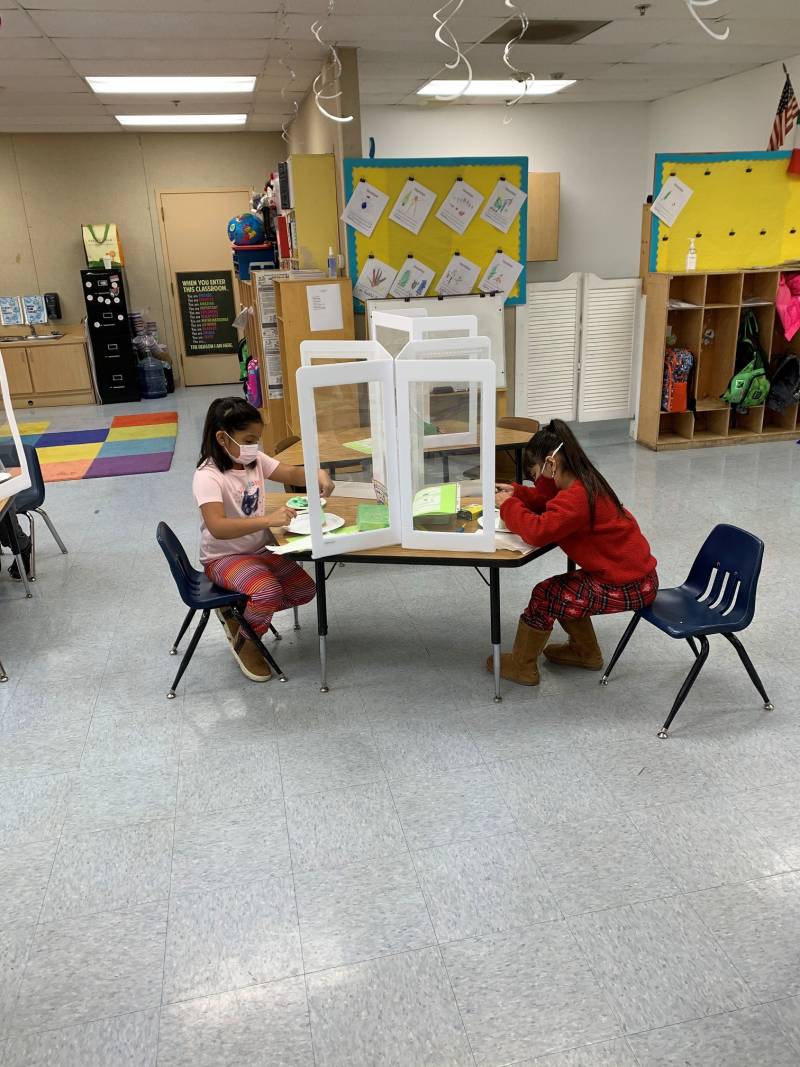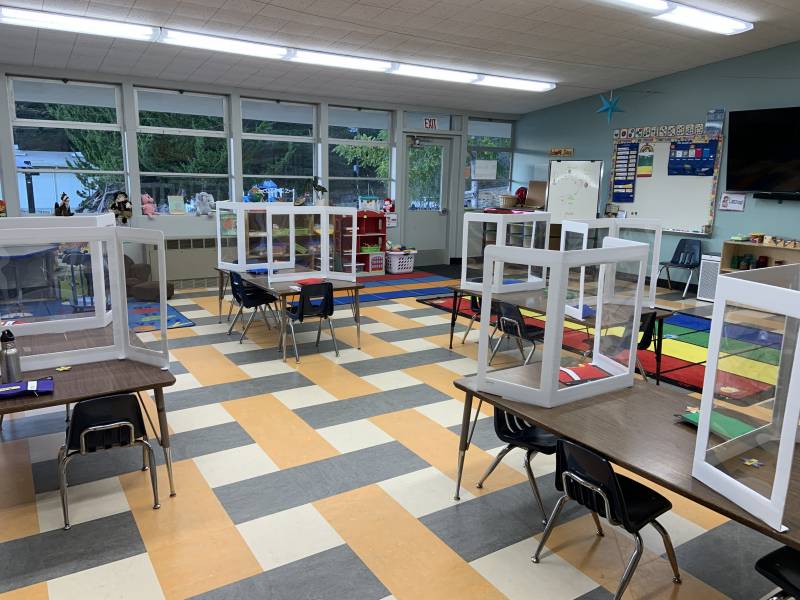Alejandra Ortega was outside her daughter Sophia's elementary school waiting for the 8-year-old to have her temperature taken — a routine coronavirus precaution — when a school employee approached, form in hand.
Would Ortega sign a release form so Sophia could be tested for the coronavirus twice a week? It only takes 15 minutes for the results, the woman told her, so kids can be screened for COVID-19 before entering the building.
“I think my first thought was, ‘No, my daughter’s definitely not going to want to participate,’ ” Ortega said.
When Ortega had received her own coronavirus test, it was less than pleasant.
“I did the nose swab, and so I wasn't too keen on it,” she said, referring to what some have described as a Q-tip up the nose to the brain.
She discussed the offer to test Sophia twice a week with her husband.
“We're like, well, this might not be a good idea,” she said.

But then she heard the tests allowed for the kids themselves to insert the swab, into the lower part of their nose. When she told her daughter, she seemed all right with it.
“For me it was like, OK, you can try once. If you feel uncomfortable, you don't have to,” Ortega said.
These self-administered swabs are part of rapid COVID-19 antigen testing, now used by nine school systems across California willing to pilot the twice-weekly testing of all students who have parental permission. Part of an attempt to reopen campuses, the program is also under consideration by several more districts, and the surveillance testing of students it offers could help build confidence in the tests as a way to prevent coronavirus transmission in schools, as well as limit the spread of the disease in communities.
San Mateo County’s La Honda-Pescadero Unified School District, where Sophia goes to school, is one of the participating systems in the program. Some of the district's schools have been open since November.
Eager to Try
With mounting evidence that students are suffering from mental health issues and learning loss, and nearly a year after schools shut their doors due to the pandemic, the hope is that rapid testing will help schools bring their students back into classrooms. The California Endowment, an organization that works to bring health care to underserved communities, is funding the program with $2 million.
Dr. Tony Iton, senior vice president for healthy communities at the endowment, says rapid antigen testing could prove to be an important tool in the process of bringing teachers and students together again — physically.
“We think we can create a school setting where the risk of an outbreak of the virus is reduced to a very, very, very low level,” Iton said. “And that would make the school a safer place to be than in a grocery store or at a restaurant or a bar.”
The tests are already used at several airports and businesses, as well as at nursing homes.
Increased testing is a substantial part of the Biden administration's strategy for reopening schools. As part of its American Rescue Plan, the administration has allocated $130 billion, with $50 billion of that earmarked for more testing of students and staff.
The La Honda-Pescadero Unified School District is eager to give the tests a try. The COVID-19 crisis has hit low-income Black and brown students particularly hard. Sixty percent of students in the district are Latino and qualify for free and reduced lunch, and nearly half are English language learners.
According to a consortium of California research institutions called PACE, low-income and English-language learners have fallen further behind compared to their peers during this period of most schools instructing students only through online learning.
That’s one reason La Honda-Pescadero Superintendent Amy Wooliever set to work early on with her staff to reopen her campuses. She oversees the semi-rural district, which spreads across San Mateo County’s southern edge. With safety protocols, including weekly tests for teachers, in place, Wooliever reopened her campuses to kindergarten through fifth grade students in November.
The number of COVID-19 cases in the community, however, have been on the rise, and she increasingly worries about school transmission.
“If we're bringing students to campus, we have to be able to ensure that we can keep them safe before they go back out into the community,” Wooliever said. “You know, our families, many of them live in shared housing. So the risk is higher if there is an incidence of COVID that we get into the home. So we just feel an awesome responsibility to be as safe as we can to a vulnerable population, particularly our essential-worker families that we serve.”
The nearest hospital for the district is an hour away. Up until November, this part of San Mateo County had been spared some of the worst effects of the pandemic. Wooliever says the district and community had been in a kind of “geographic bubble,” with few cases of COVID-19. But after lightning-sparked wildfires hit the region in August, Wooliever says, evacuations led to residents leaving the area to stay in hotels and with families and friends. When they returned, the spread of COVID-19 started to pick up.
Wooliever says being able to test students twice a week would give her a better chance of detecting any positive cases in children, then alerting their families.
“This regular testing of our children that are under the age of about 11 will give us a lot of surveillance testing on what is happening in our homes, our farms and ranches,” she said.

She also hopes data from the eight-week pilot will help her bring middle and high school students back onto campus.
Oakland Unified School District has expressed interest in the tests, Iton says. Some of the city's parents have joined a growing movement across the state trying to pressure Gov. Gavin Newsom to do more to reopen schools. Teachers unions in larger urban districts such as Oakland, San Francisco and West Contra Costa County, which includes Richmond, have resisted, saying many communities they serve have been hit hard by COVID-19, and reopening campuses would only further the spread due to students mixing in classrooms.
The data, so far, indicates that school transmission is low when safety precautions are in place, though there have been exceptions. Some medical experts, such as Dr. Naomi Bardach, an associate professor of pediatrics at UCSF, says risk of in-school transmission needs to be weighed against the growing number of children suffering learning loss and mental health issues.
Iton says Abbott’s BinaxNOW rapid antigen test, the type used in the pilot program, is efficient, cheap and highly accurate in detecting symptomatic cases, though it has been faulted for missing the virus in asymptomatic people who do not have high enough levels of the virus to test positive. The Centers for Disease Control and Prevention says antigen tests can be an important tool in an overall community testing strategy to reduce transmission, recommending serial testing to better capture cases of infection, which is what La Honda-Pescadero will do.
There, students will be shown a video on how they can self-administer their nose swabs twice a week. Results will come back 15 minutes later. Students who test positive will be sent home and given a follow-up molecular, or PCR, test, which is more accurate, to confirm the result.
Hope Swank, who works as an interpreter in an after-school program in the district, says some teachers are concerned the rapid test could instill a false sense of security. But she’s convinced that as cases rise locally, testing can help manage the pandemic, since not only will tests prevent kids who are infected from entering the building and transmitting the virus to other teachers and students, but they would also alert families that their child has the virus.
If the community knows about a case, it's done "a good job, or trying to do a good job" of "shutting down small groups so that the huge group doesn't have to get shut down,” Swank said.
She says the district works with the community resource center Puente de la Costa Sur to make sure families with positive cases get food deliveries, so they can stay isolated and receive financial help if they miss work while in quarantine.
Alejandra Ortega, who works for Puente de la Costa Sur, says some parents might be concerned about the effect on the entire family if their child tests positive.
“(N)ot just for your child and then having to stay home for two weeks," she said, "but it's also the parents and losing wages.”
But Ortega, who has been working from home while also trying to teach her own children, is grateful her district has brought them back into school. She says she’s eager to speak with other parents to see if they will participate in the new testing program. If the antigen testing can help her school remain open, she says, that’s something that can benefit her and other working parents.

